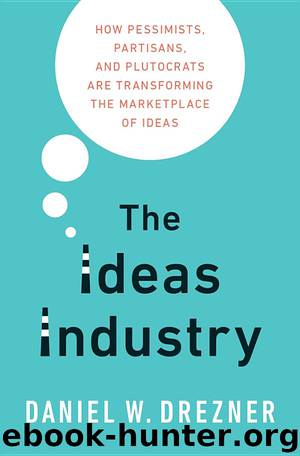The Ideas Industry by Daniel W. Drezner

Author:Daniel W. Drezner
Language: eng
Format: epub
Publisher: Oxford University Press
Published: 2017-01-15T00:00:00+00:00
8
Is the Ideas Industry Working?
The first lesson the student of international politics must learn and never forget is that the complexities of international affairs make simple solutions and trustworthy prophecies impossible. Here the scholar and the charlatan part company.
— Hans Morgenthau
THE EMERGENCE OF THE Ideas Industry has created new winners and new losers. It has empowered thought leaders more than public intellectuals, economists more than political scientists, management consultants more than think tank fellows, superstars more than anyone else. So are these changes good for the ideas? There is no denying that the public sphere is home to a far more heterogeneous array of intellectuals than in the past. The barriers to entry in American foreign policy debates are lower, and the variation of thought is wider than during the height of the Cold War. But a key test of a well-functioning marketplace of ideas is also the ease of exit. Bad or bankrupt ideas should exit the stage. Has the transformation of the marketplace of ideas improved debates about American foreign policy?
To answer that question, this chapter will take a deep dive into the uses and abuses of “disruption” in debates about the US economy and American foreign policy. As we shall see, it is the ideal case for looking at how a new notion can spread across the marketplace of ideas. The evolution of disruptive innovation as a way of thinking about how to change the world explains an awful lot about how the modern Ideas Industry functions. For good and ill, the modern marketplace of ideas strongly resembles modern financial markets. Usually, the system works. On occasion, however, there can be asset bubbles.
Economists have been aware of the importance of innovation since Adam Smith’s Wealth of Nations. When Joseph Schumpeter coined the term “creative destruction,” he captured the degree to which radical innovations could disrupt as well as create economic growth. Indeed, Schumpeter fretted that the huge fixed costs of technological innovation, combined with the risk-averse nature of bureaucratized corporations, would lead to a tapering off of radical innovations.1 The consensus among modern growth theorists is that at least 75 percent of American economic growth can be attributed to innovation. Distinguished economists from Robert Solow to Paul Romer to Robert Gordon have devoted their lives to understanding the relationship between innovation and growth.2 The most visible working theory of innovation comes not from an economist, however, but from a professor of business strategy.
A half century after Schumpeter, Harvard Business School professor Clayton Christensen coauthored a Harvard Business Review article on disruptive technologies that extended the concept of creative destruction even further.3 Christensen argued that firms generate two kinds of innovations. Sustaining innovations lead to a steady rate of product improvement over time. These incremental upgrades are necessary for leading firms in any sector to retain their customers. Disruptive innovations, in contrast, introduce an alternative set of attributes to a product. These new attributes, while promising, can also worsen performance on key dimensions, alienating mainstream customers. Leading firms
Download
This site does not store any files on its server. We only index and link to content provided by other sites. Please contact the content providers to delete copyright contents if any and email us, we'll remove relevant links or contents immediately.
The Secret History by Donna Tartt(16691)
The Social Justice Warrior Handbook by Lisa De Pasquale(11501)
Thirteen Reasons Why by Jay Asher(7815)
This Is How You Lose Her by Junot Diaz(5810)
Weapons of Math Destruction by Cathy O'Neil(5064)
Zero to One by Peter Thiel(4846)
The Myth of the Strong Leader by Archie Brown(4800)
Promise Me, Dad by Joe Biden(4463)
Beartown by Fredrik Backman(4453)
How Democracies Die by Steven Levitsky & Daniel Ziblatt(4436)
Stone's Rules by Roger Stone(4430)
The Fire Next Time by James Baldwin(4358)
100 Deadly Skills by Clint Emerson(4097)
A Higher Loyalty: Truth, Lies, and Leadership by James Comey(4047)
Rise and Kill First by Ronen Bergman(4030)
The David Icke Guide to the Global Conspiracy (and how to end it) by David Icke(3901)
The Farm by Tom Rob Smith(3886)
Secrecy World by Jake Bernstein(3795)
The Doomsday Machine by Daniel Ellsberg(3744)
